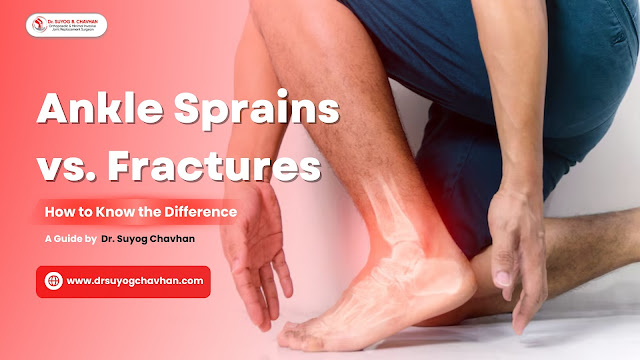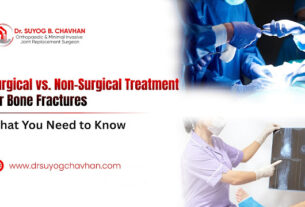Ankle injuries are a common occurrence, often resulting from sports activities, accidental falls, or missteps on uneven surfaces. Distinguishing between an ankle sprain and a fracture is crucial for appropriate treatment and recovery. In this guide, Dr. Suyog Chavhan, an internationally trained orthopedic surgeon at SYNTHESIS Orthopaedics & Joint Replacement Clinic, sheds light on the key differences between these injuries and offers insights into their diagnosis and management.
Understanding Ankle Sprains
An ankle sprain involves damage to the ligaments, the tough, elastic tissues connecting bones that support the ankle joint. This injury typically occurs when the foot twists inward, overstretching or tearing the ligaments. Common causes include:
- Sports Activities: Rapid changes in direction or jumping, especially in sports like basketball or soccer.
- Uneven Surfaces: Walking or running on irregular terrain.
- Inadequate Footwear: Wearing shoes that don’t provide proper support.
Symptoms of an Ankle Sprain:
- Pain: Ranging from mild to moderate, depending on the severity.
- Swelling and Bruising: Often localized around the affected area.
- Instability: A feeling of wobbliness in the ankle.
- Limited Mobility: Difficulty moving the ankle or bearing weight.
Understanding Ankle Fractures
An ankle fracture refers to a break in one or more of the bones constituting the ankle joint: the tibia, fibula, or talus. Fractures can result from:
- High-Impact Trauma: Such as car accidents or significant falls.
- Twisting Injuries: Similar to those causing sprains but with more force.
- Direct Blows: Impact from heavy objects or collisions.
Symptoms of an Ankle Fracture:
- Severe Pain: Immediate and intense, often preventing weight-bearing.
- Swelling and Bruising: Rapid onset, with possible deformity.
- Visible Deformity: Misalignment or abnormal appearance of the ankle.
- Inability to Move: Significant restriction in motion due to pain or structural damage.
Key Differences Between Sprains and Fractures
While both injuries share overlapping symptoms, certain distinctions can aid in differentiation:
- Pain Intensity: Sprains usually cause milder pain, whereas fractures result in severe discomfort.
- Ability to Bear Weight: Individuals with sprains might still walk, albeit with discomfort; fractures often make weight-bearing impossible.
- Deformity: Visible misalignment suggests a fracture.
- Onset of Symptoms: Fracture symptoms appear immediately post-injury, while sprain symptoms might develop gradually.
Diagnosis and Treatment
Accurate diagnosis is essential for effective treatment. Medical professionals may employ:
- Physical Examination: Assessing swelling, bruising, and range of motion.
- Imaging Tests: X-rays to identify fractures; MRI or CT scans for detailed views of soft tissues and bones.
Treatment Approaches:
-
For Sprains:
- R.I.C.E. Method: Rest, Ice, Compression, and Elevation.
- Immobilization: Using braces or splints to support healing.
- Physical Therapy: Exercises to restore strength and flexibility.
-
For Fractures:
- Immobilization: Casting or splinting to ensure proper bone alignment.
- Surgical Intervention: Required for complex fractures to realign and stabilize bones.
- Rehabilitation: Post-treatment exercises to regain function.
When to Seek Medical Attention
Immediate consultation with a healthcare provider is advisable if you experience:
- Inability to bear weight on the ankle.
- Visible deformity or misalignment.
- Severe pain or swelling.
- Numbness or tingling sensations.
Prompt medical evaluation ensures accurate diagnosis and appropriate treatment, preventing complications and promoting optimal recovery.
Conclusion
Understanding the nuances between ankle sprains and fractures is vital for effective management and recovery. If you suspect an ankle injury, seeking professional medical advice is paramount. Dr. Suyog Chavhan and the dedicated team at SYNTHESIS Orthopaedics & Joint Replacement Clinic are committed to providing comprehensive care tailored to your needs.
📍 Visit us at: SYNTHESIS Orthopaedics & Joint Replacement Clinic
📞 Call Now: +91 9082633731
📧 Email: drsuyogchavhan@gmail.com


